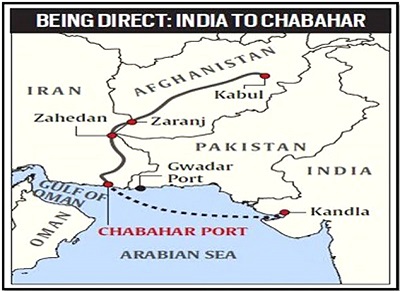Context
The recent agreement between India and Iran, extending New Delhi's rights to invest in and operate the Shahid-Behesti terminal at Chabahar Port for another decade, has garnered significant attention. The port is a critical project underpinning the economic relationship between the two nations. This deal was concluded amid a volatile period in West Asia, with ongoing conflict in Gaza, heightened Israel-Iran tensions, and the destabilizing loss of Iran’s President and Foreign Minister in a helicopter crash.
Representative of India’s Thinking
Chabahar is of paramount importance to India for both economic and strategic reasons. From India’s perspective, Chabahar is part of its extended neighbourhood strategy rather than solely its West Asia policy. The port is a crucial element of the International North–South Transport Corridor, a project aimed at linking India with Central Asia and Russia while circumventing Pakistan. Additionally, the port aligns with the new realities in Afghanistan, as the Taliban-led interim government in Kabul has pledged $35 million to the project to diversify its economic dependencies away from Pakistani ports like Karachi and the China-backed Gwadar. The significance of this support was highlighted by Taliban leader Mullah Baradar’s visit to Chabahar in November 2023.
On a bilateral level, Chabahar exemplifies the complexities in India-Iran relations. Despite public endorsements of the project, India-Iran ties would appear lackluster without Chabahar. This is due to multifaceted reasons linked to both countries’ national, regional, and geopolitical interests. Many older cooperative projects, such as the gas field Farzad-B discovered by India’s ONGC Videsh, have been abandoned. Another example is the dissolution of the IranoHind shipping company in 2013 due to sanctions. Chabahar is a legacy project dating back to 2003, a time when India was actively developing economic assets abroad, with Chabahar in Iran and Sakhalin-I in Russia being prominent examples.
A Reflection of Diplomacy
The current geopolitical landscape surrounding India’s involvement in Chabahar and Iran’s strategic maneuvers presents an intriguing case. The recent extension of the Chabahar deal followed closely on the heels of a near-conflict between Israel and Iran. Concurrently, India’s Adani Group has invested heavily in Israel’s Haifa port, purchasing it for $1.2 billion. This was facilitated partly by India’s involvement in diplomatic and economic initiatives with the United States, Israel, and Arab partners, such as the I2U2 and the India-Middle East-Europe Economic Corridor.
India’s simultaneous engagement in Haifa and Chabahar highlights its diplomatic acumen and underscores the U.S. recognition that such access benefits Washington. Recent U.S. threats of potential sanctions against Chabahar appear shortsighted. India’s ongoing relationship with Iran and the continued development of Chabahar, which provides access to challenging political regions like Central Asia and Afghanistan, could foster significant integration and offer alternatives to China-backed projects. Despite public perception, China’s financial influence and its 2021 strategic deal with Iran do not render Tehran subservient to Beijing. Iran, known for its strategic resilience, employs a diverse geopolitical strategy.
The Biden administration would do well to avoid rigidly adhering to former President Barack Obama’s approach to India-Iran relations, particularly concerning Chabahar. India’s earlier decision to cease oil imports from Iran, which once ranked among its top two suppliers, was influenced by its desire to align with U.S. nuclear deal negotiations. However, the unilateral withdrawal of the U.S. from the Joint Comprehensive Plan of Action (JCPOA) under President Donald Trump in 2018 reshaped perceptions of the non-partisanship and stability of crucial U.S. foreign policies.
The Bigger Picture
Looking ahead, two primary considerations emerge for Chabahar. Firstly, the port project should not remain the sole major initiative in the India-Iran bilateral relationship. Over-reliance on Chabahar could lead to volatility. Secondly, the U.S. should adopt a more accommodating stance on sanctions concerning Chabahar. Viewing the port solely as a collateral against adverse Iranian policies in West Asia overlooks the broader context of India’s outreach to its extended neighbourhood, which could ultimately support larger American objectives.
This perspective gains importance as the U.S. maintains indirect communication with Iran through intermediaries such as Switzerland and increasingly through Oman and Qatar. The complex geopolitics surrounding India’s involvement in Chabahar and Iran’s strategic maneuvers present a fascinating dynamic. India’s adept diplomacy in balancing its investments in both Israeli and Iranian ports demonstrates a nuanced approach that benefits from and contributes to U.S. interests.
Conclusion
In conclusion, the Chabahar Port project stands as a critical endeavor for both India and Iran, embedded in a web of economic and strategic interests. While it anchors the bilateral relationship, it also highlights the need for diversified cooperation beyond a single project. The geopolitical landscape surrounding Chabahar underscores the importance of nuanced diplomacy and strategic foresight. As India navigates its relationships with Iran, Israel, and the broader international community, the success of Chabahar will depend on continued diplomatic agility and a broader understanding of regional dynamics.
|
Probable Questions for UPSC Mains Exam
|
Source - The Hindu







